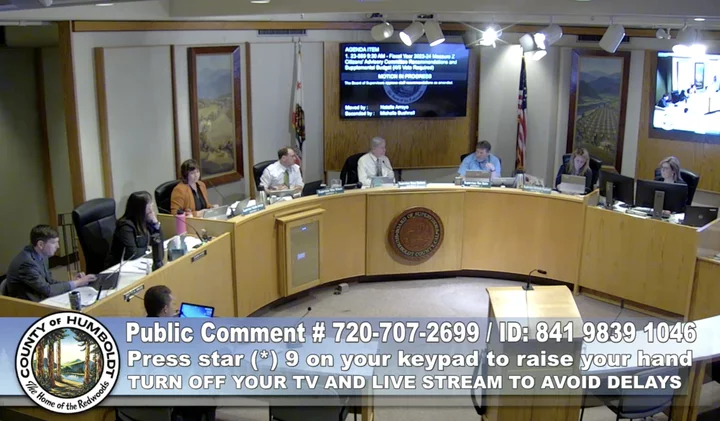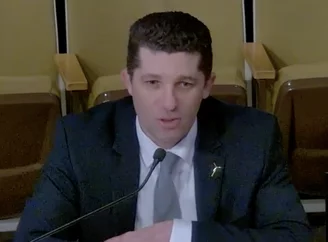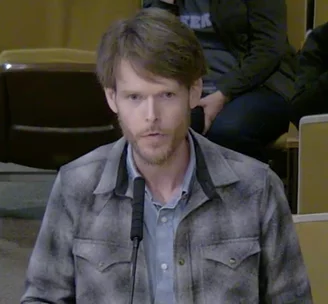Screenshot of Tuesday’s Humboldt County Board of Supervisors meeting.
###
The Humboldt County Board of Supervisors took its first look at this year’s list of Measure Z spending priorities for the upcoming fiscal year during this week’s meeting. Unfortunately, it looks as though the county is in for another year of financial distress.
“This year is a difficult year,” said County Administrative Officer Elishia Hayes said during Tuesday’s meeting. “We [don’t] have a lot of money to go around and [there are] a lot of tremendous needs across our communities.”
By the end of the meeting, everyone agreed — the money the county is taking in through Measure Z is dropping, the bulk of it is already committed to ongoing projects, and there’s no obvious corner to be cut.
Since its inception in 2014, Measure Z, the county’s half-cent sales tax for maintenance and enhancement of public safety and essential services, has proven to be a success. The measure has helped to fund hundreds, perhaps thousands of programs and individual projects over the years.
However, the last year has had a significant impact on the Measure Z fund. Due to a reduction in economic activity across the county, sales tax revenues have dropped, cutting millions of dollars from the county’s projected income. To make matters worse, inflation and rising costs have increased county expenses, including higher employee salaries and more expensive benefits, leaving significantly less funding for Measure Z allocations.
The county is expecting to bring in $12.67 million in Measure Z revenue for fiscal year 2023/24, $1.8 million less than staff’s estimate for the current fiscal year, according to Deputy CAO Sean Quincey. Current expenditures are expected to exceed $12 million, leaving approximately $623,429 for discretionary spending.
Quincey floated a possible idea that the staff had come up with: Eliminate some county jobs that have remained empty for some time.
“I will note that in the current year, when we went down the list and allocated more projects or funded more projects, the board allocated 16 additional county staff positions and of those positions, only one of them is currently filled at the time,” Quincey continued. “A topic for your board to consider as we look ahead to [fiscal year] 2023/24 is what to do with those positions that were allocated in 2022/23.”
Deallocating all of the positions would save the county approximately $1.6 million in the coming fiscal year, according to the staff report. Public Works is the only department that has used one of the vacant positions.
During public comment, Public Works Director Tom Mattson chose not to speak to the current funding allocations being discussed, noting “it is what it is” and “there’s just no money for anything extra.” Instead, Mattson asked the board to keep its word and continue to fund positions that were allocated last year.
“It’s not for lack of recruiting that we have not been able to hire equipment operators or maintenance workers,” he said. “The mowing crew – we have ordered the mowers already and they are being constructed. … This is going to leverage significant additional funding if we can get these positions filled. … We believe we have a solution that’s going to make us very competitive in the market and within our budget. I would just caution you … to not cut the positions that were already allocated last year.”
Meanwhile, several representatives from organization that are receiving ongoing funding from Measure Z — particularly those that deal with emergency services like policing and fire protection — made the case for continuing those programs, rather than cutting back.
Several representatives of the City of Fortuna and the Fortuna Police Department also spoke during public comment to advocate for Measure Z funding. Citing the dramatic rise of fentanyl abuse and overdose-related deaths in Humboldt County, Fortuna Mayor Tami Trent underscored the need for a robust drug task force.
“I know you have a very tough job ahead of you with very little money to fund the deserving applications,” she said. “Tracking [the fentanyl] mortality rate … Humboldt County is significantly higher than any other California county. Fortuna is one of the agencies that has been able to have [an officer on the drug task force] for eight years now and it’s been funded through the county. … The drug task force has been very successful in the whole county and it does save lives getting these drugs off the street.”
Fortuna Police Chief Casey Day echoed Trent’s concerns and emphasized the importance of having a school resource officer on duty to facilitate drug education in schools throughout the Eel River Valley, not just Fortuna.
Representatives of the Humboldt County Fire Chiefs’ Association and local volunteer fire districts advocated for their chunk of funding but also questioned the sustainability of Measure Z amid increasing county costs.
“There are no salaries involved [for us], so every year we have to queue for funding,” said Telegraph Ridge Volunteer Fire Chief Peter Lawsky. “We come hat in hand every year to try and adequately fund the volunteer fire departments. We provide emergency services in all the rural areas. … We continually need funding to be able to provide these services.”
Lawsky added that the $1,066,051 supplemental budget request for the Humboldt County Fire Chiefs Association would contribute to dozens of separate agencies across the county.
Many of those districts, especially in rural Southern Humboldt, have been using the same engines and equipment for decades.
“If we asked our sheriff’s deputies to ride the calls in 1990s trucks and then do it for free, they’d have a hard time doing that. That’s arguably what we’re going to have our volunteers do,” said Shelter Cove Volunteer Fire Department Chief Nick Pape. “If we only have 15 sets of fire turnout gear, we’re not going to be looking for [additional] firefighters until the funding is available. We have fire departments in our area that are literally funding their department by selling blackberry pies and hamburgers. … If we do not get the funding for that, these departments don’t have a plan B or C.”
But several people intimately involved with the spending of Measure Z funds over the last few years questioned whether this was the best mechanism to fund these service. Before returning to the board for discussion, Justin Robbins, chair of the Measure Z Citizens’ Advisory Committee, urged the board to reevaluate the sustainability of Measure Z.
“And that’s really, really difficult to do … given all of our challenges,” he said. “What we need for stable funding is stable economies and economic growth in our county. This last year was very, very challenging given the amount of funding that was available, and I support the recommendation that was made by the committee. I also want to say that I would want to advise my fellow committee members … and the Board of Supervisors that I think what’s important going forward … is that we fund projects that leverage other funding sources that leverage creativity and leverage in-kind labor.”
Glen Ziemer, vice-chair a former member of the advisory committee, warned that increasing payroll expenses and other county expenditures will inevitably “consume the totality of the fund.”
“Unfortunately, there have been two factors that have advanced that process,” Ziemer explained. “The first being the significant compensation package that was offered to the county’s law enforcement officers. Certainly, they deserve it … but the simple fact is you raised the cost of your law enforcement component somewhere north of 30 percent. The second factor that complicates Measure Z specifically is the fact that during the period of time that you didn’t have a functional auditor-controller, the fund balances were never identifiable.”
To avoid exhausting the Measure Z revenue and to “bring back a representative and transparent process,” Ziemer suggested that the Board of Supervisors divvy up the fund into internal and external divisions. “You are already at the point … where there is no capability for external agencies to be funded,” he said. “If, in fact, the goal of Measure Z is to provide the best service to the community, you cannot make a credible argument that that’s accomplished simply by using it as a payroll funding mechanism for the county position.”
One by one, each member of the board acknowledged the difficult decision at hand.
“All of these applications are worthwhile,” Second District Supervisor Michelle Bushnell said. “[This is] painful work, especially when there’s not enough funding.”
Hayes noted that the county had “roughly $200,000 to $300,000” in addition to the $623,429 in projected available funds for the next fiscal year. However, “due to the volatility of the revenues of Measure Z,” she asked the board to hang onto those dollars for the time being.
“We’re in there looking every single month to see what kind of change is occurring and a swing of a half million dollars is commonplace right now,” she said. “It’s very difficult for me to say that we will definitely have funds to roll over and carry forward from the current year.”
Fourth District Supervisor Natalie Arroyo also expressed her support for the ad hoc committee’s list of recommendations and acknowledged the difficult decision facing the board. “You know, to sit here and go through the list of projects and decide which is the most needed or wanted in their community really is like cutting the baby in half,” she said. “I sort of hate that euphemism, but it really speaks to how difficult it is and how valuable all of these projects are.”
Arroyo said she would be in favor of a percentage-based spending allocation plan that would be reflective of years past to help guide the decision-making process and suggested staff bring back additional information on the subject at a future meeting.
Third District Supervisor Mike Wilson agreed with Ziemer’s previous comments, noting that, while Measure Z has been “very successful,” it has also backed the county into a corner.
“I wouldn’t mind some analysis around that to really take a look at where we’re at … and see what we’ve allocated and kind of consider permanent these days, especially if we’re going to be going into more budget discussions. … I would recommend that there be some interface with some members of this board [and the ad hoc committee] to have those conversations about the long-term elements of this.”
Wilson added that he didn’t feel comfortable making a decision on the list of Measure Z recommendations just yet.
Fifth District Supervisor and Board Chair Steve Madrone said it “would be foolish” to move ahead with the ad hoc committee’s recommendations without further information. However, Madrone said the board could take a couple of smaller actions to move the process forward, such as approving staff’s recommendation for the supplemental budget for the Humboldt County Fire Chiefs’ Association. He also suggested appointing two board members to the Measure Z Citizens’ Advisory Committee to “really look at how to fix what is obviously becoming somewhat broken.”
“This is kind of the start of our delving into our whole budget in a way,” he said. “Even though it’s not, it’s just Measure Z, we are delving into our budget and we already know that our revenues are way down, and our expenses are up. That’s not a pretty picture. We’re going to have to dig deep to deal with that and often that requires us to use our reserves.”
After some additional discussion on the matter, Arroyo made a motion to approve the supplemental budget request for the Fire Chiefs’ Association and authorize the CAO to allow flexibility within the spending plan. She also asked the CAO’s office to bring back recommendations about policy to establish guidance for one-time projects, a percentage-based allocation plan and to appoint two members of the board to the ad hoc committee. Bushnell seconded the motion.
The board agreed to appoint Bushnell and Wilson to the ad hoc committee. The motion passed in a unanimous 5-0 vote.
The board will revisit the remaining Measure Z recommendations at a future meeting.



CLICK TO MANAGE